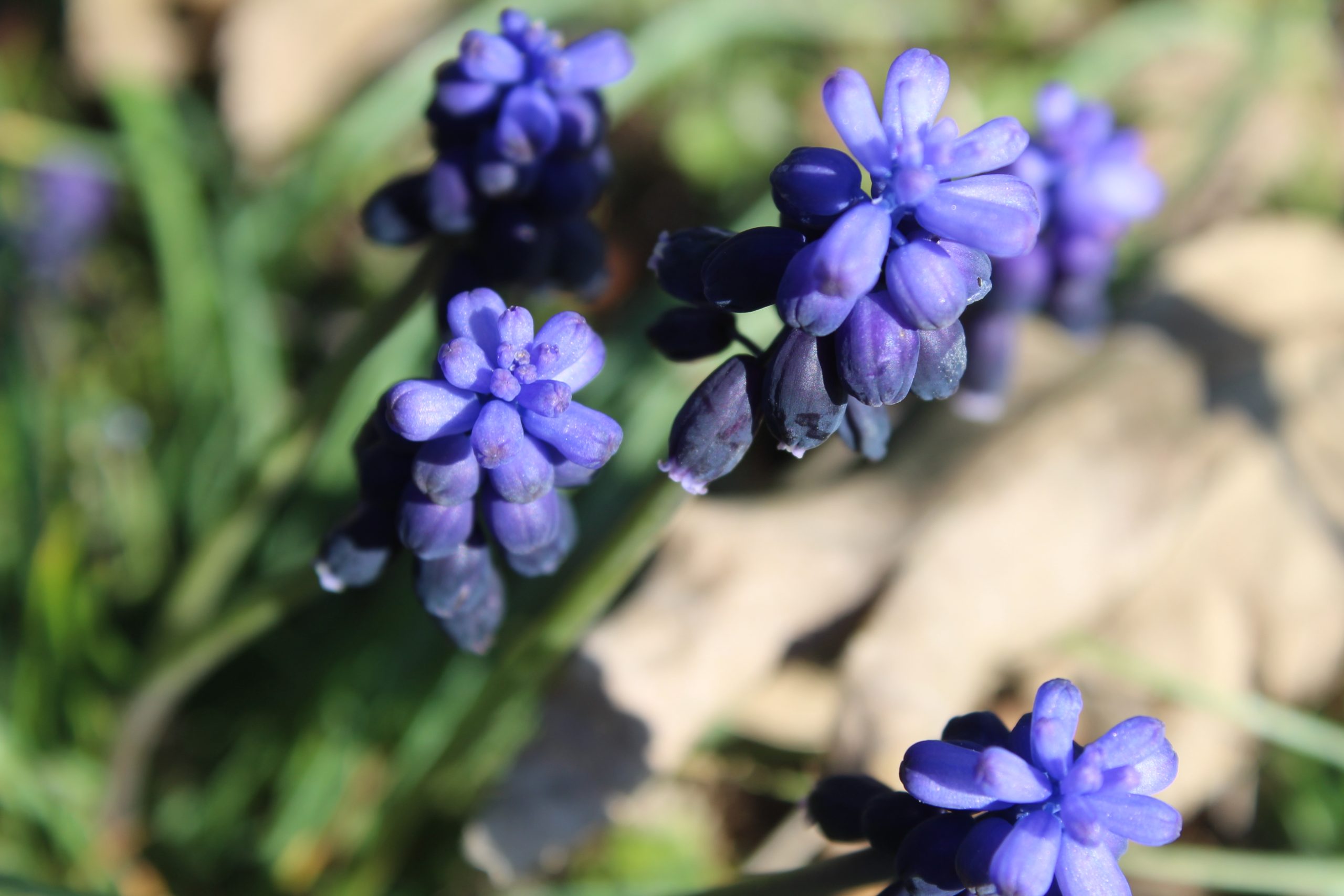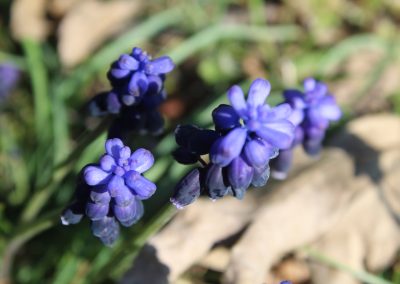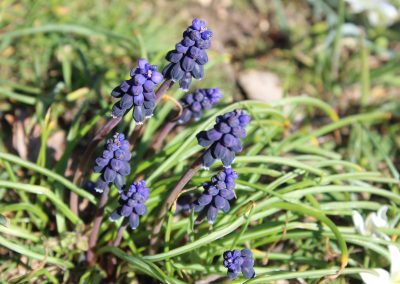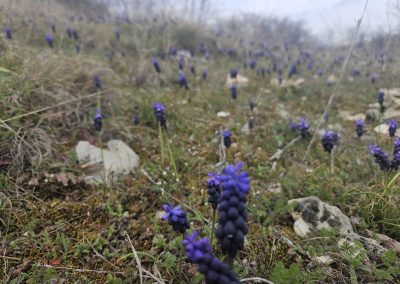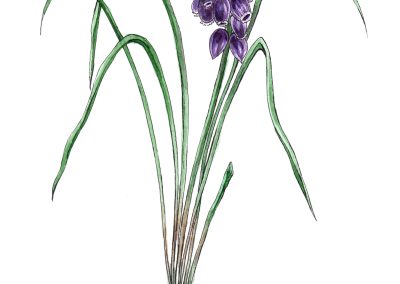Muscari neglectum
Scientific description
Muscari Neglectum-Racemosum
Taxon: Angiospermatophyta (Magnoliophyta)
Class: Monocotyledonatae (Liliatae)
Subclass: Liliidae
Order: Asparagales (Liliales)
Family: Asparagaceae (Liliaceae)
Origin: Southern Europe and Asia
Common name: Muscari/Grape Hyacinth
Description:
Herbaceous, perennial plant with a bulb, 10–20cm tall. Flower stems up to 20cm. Leaves appear before flowers, shorter than inflorescences at first, then longer, elongated, linear, medium green, definite edges. Top has a raceme of vivid blue tubular flowers with white lobes, sometimes pale flowers. Raceme 2–6 cm long. Flowers hermaphrodite, rich in nectar. Fruit is a loculicidal capsule, 3 locules, two ovules each. Blooms in March–April.
Propagation: Seeds or bulbils.
Ecology:
Grows spontaneously in forests, clearings, meadows; prefers rocky, sandy soils. In Dobrogea, thrives on sunny slopes.
Use:
Planted in gardens and parks as decorative; grows and multiplies rapidly. Bulbs contain acids. Provides early spring nectar for bees.
Threat:
Bulb poisonous due to comisic acid (acts like saponin). Can be invasive in gardens.
Muscari neglectum
Încrengătura: Angiospermatophyta (Magnoliophyta)
Clasa: Monocotyledonatae (Liliatae)
Subclasa: Liliidae
Ordinul: Asparagales
Familia: Asparagaceae
Origine: Europa de sud și Asia
Denumire populară: zambilă moțată
Descrierea:
Plantă ierboasă, perenă cu bulb, 10–20 cm. Tulpini florale până la 20 cm. Frunzele apar înaintea florilor, inițial mai scurte decât inflorescențele, apoi mai lungi, alungite, liniare, verde-mijloc, cu margini întregi. În vârful tulpinii se află un racem de flori tubulare albastre cu lobi albi, uneori flori palide. Racem 2–6 cm lungime. Florile hermafrodite, bogate în nectar. Fructul este capsulă loculicidă cu 3 celule, două ovule fiecare. Înflorește martie–aprilie.
Înmulțire: prin semințe sau bulbi.
Ecologia:
Crește spontan în păduri, poieni, pajiști; preferă soluri pietroase, nisipoase. În Dobrogea se dezvoltă bine pe versanți însoriți.
Utilizare:
Plantată în grădini și parcuri ca decorativă; crește și se înmulțește rapid. Bulbii conțin acizi. Oferă nectar timpuriu albinelor.
Pericol:
Bulbul este otrăvitor datorită acidului comisic (acțiune ca saponina). Poate fi invazivă în grădini.
Muscari neglectum – Μούσκαρι το παραμελημένο
Φύλο: Αγγειόσπερμα (Magnoliophyta)
Κλάση: Μονοκοτυλήδονα (Liliatae)
Υποκλάση: Liliidae
Τάξη: Ασπαραγκοειδή (Asparagales)
Οικογένεια: Asparagaceae
Καταγωγή: Νότια Ευρώπη και Ασία
Κοινή Ονομασία: Ζαμπίλια με λοφίο
Περιγραφή:
Πολυετές φυτό με βολβό, ύψος 10–20 εκ. Βλαστοί λουλουδιών έως 20 εκ. Φύλλα εμφανίζονται πριν τα άνθη, αρχικά μικρότερα από τις ταξιανθίες, μετά μεγαλύτερα, μακρόστενα, γραμμικά, μεσαίου πράσινου, άκρες ολόκληρες. Στην κορυφή ράκεμη μπλε σωληνοειδή άνθη με λευκούς λοβούς, μερικές φορές χλωμά άνθη. Ράκεμη 2–6 εκ. άνθη ερμαφρόδιτα, πλούσια σε νέκταρ. Καρπός κάψα 3 θύλακες, δύο ωοθήκες ανά θύλακα. Ανθίζει Μάρτιος–Απρίλιος.
Πολλαπλασιασμός: με σπόρους ή βολβούς.
Οικολογία:
Ανθίζει σε δάση, ξέφωτα, λιβάδια. Προτιμά πετρώδη, αμμώδη εδάφη. Στην περιοχή Δοβρογίας αναπτύσσεται καλά σε ηλιόλουστες πλαγιές.
Χρήση:
Φυτεύεται σε κήπους και πάρκα ως διακοσμητικό, αναπτύσσεται και πολλαπλασιάζεται γρήγορα. Οι βολβοί περιέχουν οξέα. Παρέχει πρώιμο νέκταρ στις μέλισσες.
Κίνδυνος:
Βολβός τοξικός λόγω οξέος κομισικικού (δράση σαπωνίνης). Μπορεί να είναι επεμβατικό σε κήπους.
Muscari Neglectum-Racemosum
Taxon : Angiospermatophyta (Magnoliophyta)
Classe : Monocotylédones (Liliacées) Monocotyledonatae (Liliatae)
Sous-classe : Liliidae
Ordre : Asparagales (Liliales)
Famille : Asparagaceae (Liliaceae)
Origine : Europe du Sud et Asie
Nom commun : Muscari/Hyacinthe de raisin
Description :
Plante herbacée vivace avec bulbe, hauteur 10–20 cm. Tiges florales jusqu’à 20 cm. Feuilles apparaissent avant fleurs, d’abord plus courtes que les inflorescences, puis plus longues, allongées, linéaires, vert moyen, bords définis. Racème au sommet, fleurs tubulaires bleu vif avec lobes blancs, parfois fleurs pâles. Racème 2–6 cm. Fleurs hermaphrodites, riches en nectar. Fruit capsule loculicide, 3 loges, deux ovules chacune. Floraison mars–avril.
Propagation : Graines ou bulbilles.
Écologie :
Pousse spontanément dans forêts, clairières et prairies; sols rocailleux et sablonneux. En Dobrogea, prospère sur pentes ensoleillées.
Utilisation :
Plantée dans jardins et parcs comme décorative, pousse et se multiplie rapidement. Bulbes contiennent acides. Fournit nectar tôt au printemps pour les abeilles.
Menace :
Bulbe toxique dû à l’acide comisique (action comme saponine). Peut être envahissant dans les jardins.
Creative writing inspired by Muscari neglectum
Written by Petrescu Alexandru
The Tears of Melanthia – A Grape Hyacinth Myth
In days of old, when the worlds of gods and men touched like entwined vines, there lived a maiden named Melanthia, renowned in the land for her laughter—a light, airy sound like spring showers. She was the daughter of Demeter's handmaid and spent her days in the holy pastures, weaving garlands for Persephone. The gods loved her, and flowers sprouted behind her.
But on a single spring when Persephone had yet to come back from the underworld, a pall of shadow crept over the land. Melanthia strayed further than ever before, with a sad heart. She encountered there near a still pond where even reeds were sobbing in anguish a form unseen wrapped in darkness—a spirit of the lost thing, neither god nor ghost.
The spirit asked her, "Why do you mourn for one who ever leaves?" And Melanthia said, "For I love her, and love does not seek only summer."
The goddess, moved by her devotion, offered her a choice: remain in the world above and forget her sorrow, or descend to the underworld and share Persephone's long darkness. Melanthia did not hesitate and chose the latter.
Demeter, mourning to have lost another spring daughter, wept among the meadows where Melanthia had played. From where she wept upon the earth, grew clusters of small blue-purple flowers—no resplendent yellow like daffodils, no red-hot like tulips, but soft and steadfast. These were the grape hyacinths, flowering early in the spring, before Persephone's return, as a reminder of Melanthia's tender heart and constant loyalty. Even to this day, grape hyacinths remain at the threshold of spring and winter—a bridge of sorrow, love, and loveliness of waiting.


